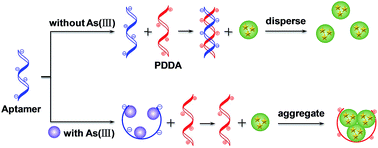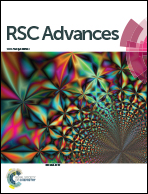Target induced aggregation of modified Au@Ag nanoparticles for surface enhanced Raman scattering and its ultrasensitive detection of arsenic(iii) in aqueous solution†
Abstract
A highly sensitive surface-enhanced Raman scattering (SERS) approach for the selective detection of trace arsenic ions was reported based on cationic polymer (PDDA) and 4-mercaptopyridine (4-MPY)-modified Au@Ag nanoparticles (Au@AgNPs) as the effective enhanced substrate, in which 4-MPY was used the Raman reporter. When As(III) ions were added to the system, As(III) specifically interacts with the Ars-3 aptamer to form an As(III)–aptamer complex, so that the PDDA can aggregate 4-MPY-modified Au@AgNPs and cause the dramatically enhancement of the Raman signals. Under optimal assay conditions, the limit of detection (LOD) was estimated to be as low as 59 ppt, which is lower than the WHO defined limit (10 ppb). The determination of As(III) in real water samples was also carried out to confirm the practicability of our method. Therefore, the target induced aggregation of modified Au@AgNPs enhanced Raman spectroscopic technique offers great potential practical applications for the on-site and ultrasensitive detection of As(III) in environments.

- This article is part of the themed collection: Surface enhanced Raman Spectroscopy: Editors collection for RSC Advances

 Please wait while we load your content...
Please wait while we load your content...